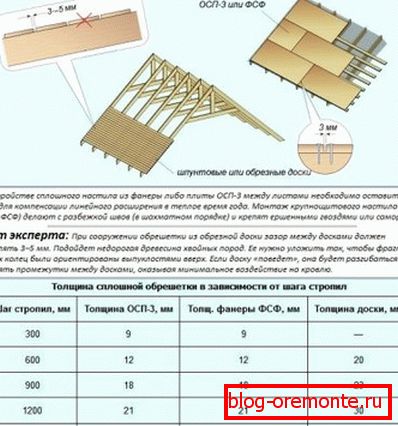Preparation of the roof under a soft roof - photo and video
Shingles in recent years has become one of the most popular roofing, thanks to its original appearance, imitating the classic ceramic tiles. The simple technology of fixing the shingles with the help of a self-adhesive layer simplifies self-laying of the material, but thorough preparation is required before beginning the installation work of the roof structure. In this article we will describe how the device of the roofing pie is made under the soft tiles.
Material Features
Soft roofing is called shingles, which are made from fiberglass or polyester impregnated with modified oil bitumen or synthetic rubber. The outer surface of the shingle is sprinkled with basalt or mineral crumb to impart color, texture and mechanical strength to the material. Soft tiles are produced in the form of tiles with a figured edge, the length of which is 100 cm, width 30-45 cm, and thickness 0.3-0.45 mm. This roofing has the following features:
- A light weight. The square meter of a soft roof weighs no more than 13 kg, which makes it possible not to weight the device of the rafter frame with additional elements.
- Flexibility. The material has high elasticity and flexibility, so it is easy to fit on the roofs of complex shape.
- Durability. The service life of a roof with such a coating is up to 70 years, and it does not require special maintenance.
- Resistance to environmental factors. Soft roof appreciate for high moisture resistance, tolerance to the effects of ultraviolet radiation and temperature changes.
Note! Soft roofs are not recommended to be installed on structures with a high risk of fire, as it relates to flammable materials. To reduce the likelihood of fires, the device of the rafter frame is performed with the obligatory treatment of fire-blocking drugs.


Nuances of work
The soft roof is fixed on the base with the help of a self-adhesive layer of low-melting bitumen on the underside of the material protected by a polyethylene protective film. Roofing of shingles can be performed only under certain weather conditions:
- The temperature of the ambient air should not be lower than 5-10 degrees, because otherwise the bitumen layer will have to be reheated forcibly with a construction dryer or a gas burner, risking damage to the tiles.
- The temperature of the ambient air should not exceed 25 degrees, so that the bitumen layer does not melt and does not flow down the slope during the construction of the roof.
- The device of a soft roof is carried out in dry, not rainy weather on the dried basis in order to prevent rotting of the rafter frame and the final coating during operation.
Important! Store shingles for roofing should be in a dry, protected from direct sunlight place to prevent melting adhesive layer of the bitumen. It is not recommended to remove the protective film from the shingle in order to avoid sticking of the material before mounting the coating.

Base Requirements
The device of a soft roof begins with the preparation of the base, the durability and moisture resistance of the structure depend on the strength and reliability of which. The process of creating a roofing pie for bitumen roofing should be carried out strictly in accordance with the technology. The base provides shingles with the following conditions:
- Mechanical strength. A soft roof is placed exclusively on a continuous crate, as it is not capable of keeping its shape on its own. Therefore, the base for mounting the coating is made from sheets of moisture-resistant plywood or particle board.
- Smoothness. The bottom surface of the flexible roof is easy to damage, so laying is done on the lining carpet, however, and the base does not interfere with cutting and releasing from the knots and chipping.
- Smooth surface. Installation of shingles roof does not tolerate curvature. Any bias crates will lead to gaps between the shingles.
- Ventilation. The ventilation gap between the roofing shingles and the roof frame must be at least 50 mm to avoid the "greenhouse effect" and the appearance of condensate.
Keep in mind that compliance with the base of the correct technology ensures a long life of the roof, no leakage and mechanical damage to the frame.


Technology preparation
The roofing pie, which is used to build a soft roof, consists of a vapor barrier, insulation, waterproofing, contra grating, sparse lathing, lining carpet and finishing cover. The quality of the design depends on the correctness of the calculation, sequence and compatibility of materials. Preparation of the roof under the soft tile is as follows:
- First of all, it is necessary to check the condition of the rafter frame. All rotten elements need to be replaced. Reprocess with fire retardant and antiseptic.
- On top of the rafters stripes overlap secure vapor-permeable membrane waterproofing. Waterproofing material is fixed with a construction stapler with sagging in order to avoid rupture in case of leakage.
- On top of the waterproofing they fix the slats of a 3-4 cm thick counter-grill to ensure a ventilation gap. Then, perpendicular to the rafters, they fix a sparse crate of a cut board with a step of 30-50 cm.
- Plywood sheets or OSB are nailed to an additional crate, making a gap of 1-3 mm between them.
- On a solid base lay lining carpet, which later laid a soft roof.
Experienced craftsmen note that a high-quality, reliable base device makes the bitumen roof more durable and resistant to mechanical damage. Therefore, in the process of work, it is necessary to strictly observe the technology and recommendations of manufacturers.

